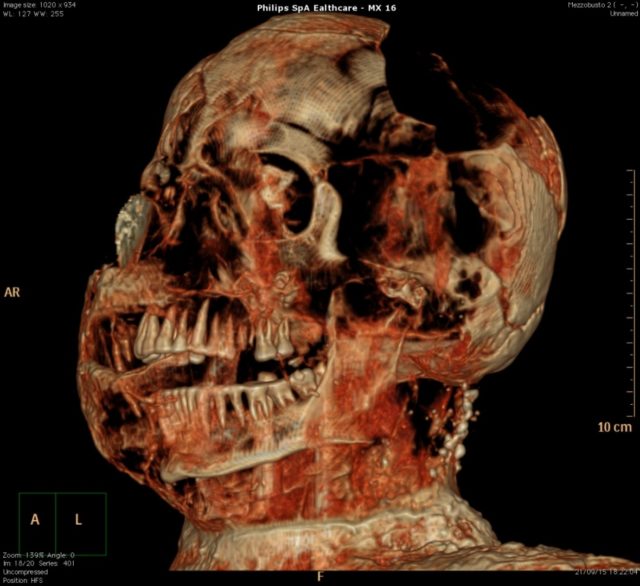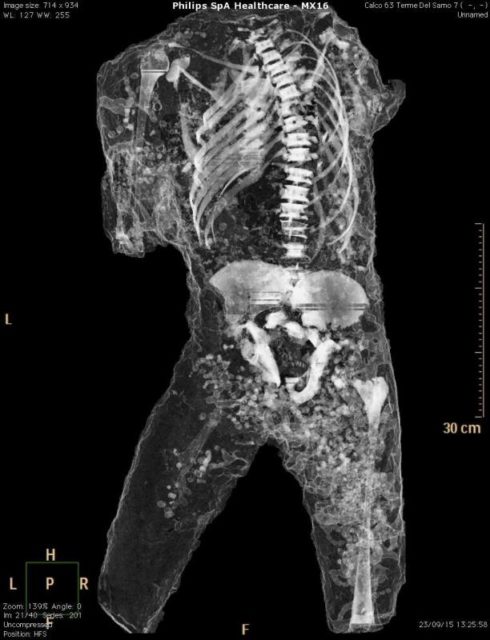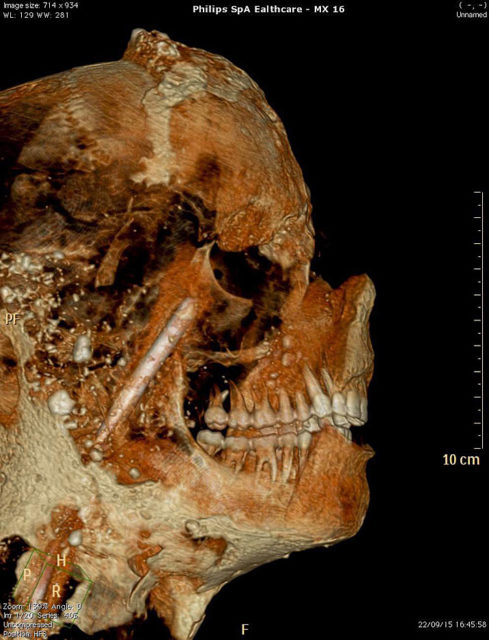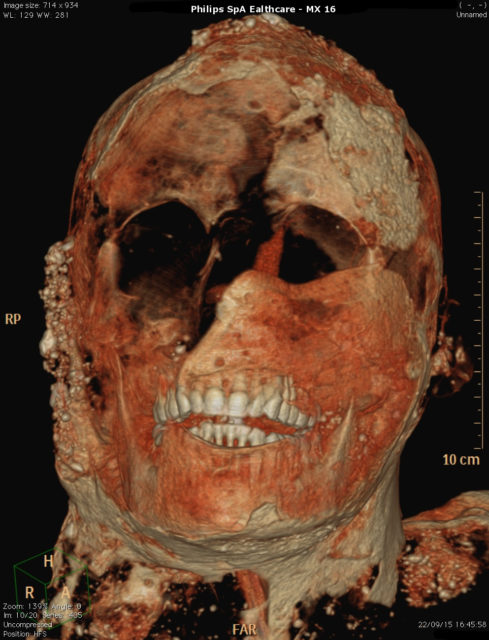
The victims of the 79 AD eruption of Mount Vesuvius have been entombed in ash for more than 1,900 years. Now, with the help of modern-day imaging technology, the people of Pompeii are being brought back to life.
Through the years, many of the victims have been encased in plaster casts in a bid to aid their preservation. The majority of casts being made in the mid-19th century, meaning that some are in desperate need of repair. In order to restore them, researchers have had to break into the casts, at the risk of damaging the remains. All images: pompeiisites.org
Back in 1984, resin was used on one skeleton, allowing the victim’s hair and hairpin to be captured impeccably. Resin casting, however, is not only difficult, but also expensive. This means that this method has only been used once and experts returned to plaster.

Dissatisfied with plaster casts, archaeologists have been searching for different ways to preserve the bodies. Although relatively inexpensive, plastering is not without its own issues. Stefania Giudice, a conservator from Naples national archaeological Museum who is working on the Pompeii victims, explained, “The bones [of the victims] are very brittle so when we pour in the plaster, we have to be very careful, otherwise we might damage the remains and they would be lost to us forever.”
The plaster mixture has to be a precise consistency; it must be thick enough to support the skeleton, but thin enough to be able to capture as many details as possible. Once mixed, the plaster has to be carefully poured into the void in the ash, through a narrow entrance to capture a person’s pose. Once the cast was poured, the archaeologists would return a few days later and remove the cast from the hole.
Archaeologists are now using scanning technology, namely, computerized axial tomography (CAT) machines — also known as CT scanners — are used because they produce detailed 3D models of the remains. Tomography is also used. This is the process of creating a 2D image of a 3D image. Doctors use tomography when they want to examine the body one “slice” at a time in order to focus on specific areas. Now, researchers are using it on human remains — it has even been used to study Egyptian mummies.


So far, the scans have revealed many previously unseen details. For example, researchers were surprised at the state of the Romans’ teeth. Overall, they are in excellent condition, given the time period during which the people lived. From this information, researchers suggest that the Romans must have had a low sugar, high fiber diet and may have even had eaten healthier than we do.
Other details were less surprising. Many of the victims’ scans showed that they suffered from severe head trauma, probably sustained from collapsing buildings or falling rubble during the earthquakes that followed the eruption. The poses of the people show how they died; some were trapped in buildings, whilst others sheltered with family members. One victim was frozen in time with his hands above his head in a protective gesture, seemingly in an attempt to stave off death.
The experts at the Pompeii Archaeological Site have been readying the poignant remains for the exhibition called Pompeii and Europe. These researchers also used handheld scanners to determine the features and positions of the bodies beneath the casts. Such mobile scanners are useful, especially for casts that are too fragile to fit inside the larger scanners. Another benefit of scans is that they reduce the possibility of restorers from accidentally damaging the remains.

Perhaps the most somber discovery was the body of a young boy. The boy, believed to be around four years old when he died, was found alongside an adult male and female, who are presumed to be his parents. A younger child, a sibling, appeared to be asleep on the mother’s lap.
The director of the laboratory at the Pompeii Archeological Site, Stefano Vanacore, was the one to carry the remains of the petrified child out of the ruins. Once removed from the site, the little boy was scanned. The plaster cast had preserved his clothing, but the scans revealed his skeleton. On one such scan, viewers can plainly see how the young boy’s lips are pursed, as if in shock.
“It can be very moving handling these remains. Even though it happened 2,000 years ago, it could be a boy, a mother or a family. It’s human archaeology, not just archaeology.” Said Dr. Giudice.
Contrast dye is sometimes used in the scans. One specific dye mimics the appearance of muscles and skin, but the eye sockets remain empty, giving the pictures a macabre feel.
Before the eruption of Mount Vesuvius, Pompeii was a large Roman town in the Italian region of Campania. When the volcano did erupt, it spewed ash hundreds of feet into the air for eighteen long hours. The ash fell on the town, choking residents and covering buildings. Then, the next morning, the cone of the volcano collapsed and caused an avalanche — traveling at 100 mph (160 kmh) — of mud to flood Pompeii. It was this avalanche that killed so many people.
One Roman writer, Pliny the younger, described the panic during the eruption of Mount Vesuvius. He said that terrified Romans living in the towns of Pompeii and Herculaneum saw “sheets of fire and leaping flames” as they ran through dark streets carrying torches with pumice stone raining down upon them.
The ash that fell was what allowed preservation of the victims to occur. The flaky material hardened to form a porous shell so that although the soft tissues of the bodies decayed, the skeleton remained.
Reports from the time claim that two thousand people died in Pompeii. Today, however, it is estimated that anywhere between 10,000 and 25,000 residents of Pompeii and nearby Herculaneum were killed on the spot. Understandably, the location was abandoned until it was rediscovered in 1748. Pompeii is now classified as a Unesco World Heritage Site and receives more than 2.5 million tourists each year.
Since its rediscovery, Pompeii has been a treasure trove of artifacts. For example, in November, French and Italian archaeologists excavating areas of the ancient town found raw clay vases that appear to have been dropped by Roman potters fleeing the disaster. Many of the buildings, including all they held, were found intact under the layer of debris and ash.
So far, only around 100 of the victims have been captured in plaster. The total number of bodies to be found is approximately 1,150, and that’s with a third of the city left untouched by archeologists.
